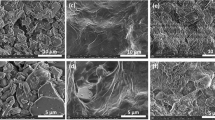Abstract
Growing environmental concerns have fueled the need for efficient separation of oil–water mixtures. Membranes that separate oil–water mixture based on contrasting wetting properties have recently received significant attention. Here, hydrophobic and oleophilic ceramic membranes have been successfully prepared for the application of water-in-oil emulsion separation. The membranes were fabricated by modification the ZrO2 membrane with hexadecyltrimethoxysilane (HDTMS). SEM, EDS, and pore size measurements depict that HDTMS has been grafted onto the ZrO2 membrane surface without changing the membrane morphology and pore structure. Contact angle measurements confirm that HDTMS modification improves the membrane hydrophobicity and oleophilicity. The modified membrane was thermally stable to 220 °C, and had good chemical stability in a series of organic solvents, even under high-speed scouring. The antifouling performance of the modified membrane was assessed via the filtration of water-in-oil emulsions. The modified membranes showed higher oil flux and higher water rejection compared with the unmodified membranes. The modified membrane can separate all the water droplets from the water-in-oil emulsions. The hydrophobicity of the grafted HDTMS chains was considered to be responsible for reducing the water droplet adsorption on the membrane surface.














Similar content being viewed by others
References
Wang CF, Tzeng FS, Chen HG, Chang CJ (2012) Ultraviolet-durable superhydrophobic zinc oxide-coated mesh films for surface and underwater–oil capture and transportation. Langmuir 28(26):10015–10019
Jin M, Wang J, Yao X, Liao M, Zhao Y, Jiang L (2011) Underwater oil capture by a three-dimensional network architectured organosilane surface. Adv Mater 23(5):2861–2864
Kajitvichyanukul P, Hung YT, Wang LK (2011) Membrane technologies for oil–water separation. In: Wang LK, Chen JP, Hung YT, Shammas NK (eds) Membrane and desalination technologies. Humana Press, New York, pp 639–668
Chang Q, Zhou J, Wang Y, Liang J, Zhang X, Cerneaux S, Wang X, Zhu Z, Dong Y (2014) Application of ceramic microfiltration membrane modified by nano-TiO2 coating in separation of a stable oil-in-water emulsion. J Membr Sci 456:128–133
Lobo A, Cambiella Á, Benito JM, Pazos C, Coca J (2006) Ultrafiltration of oil-in-water emulsions with ceramic membranes: influence of pH and crossflow velocity. J Membr Sci 278(1–2):328–334
Tao M, Xue L, Liu F, Jiang L (2014) An intelligent superwetting PVDF membrane showing switchable transport performance for oil/water separation. Adv Mater 26(18):2943–2948
Shi Z, Zhang W, Zhang F, Liu X, Wang D, Jin J, Jiang L (2013) Ultrafast separation of emulsified oil/water mixtures by ultrathin free-standing single-walled carbon nanotube network films. Adv Mater 25(17):2422–2427
Zhang W, Shi Z, Zhang F, Liu X, Jin J, Jiang L (2013) Superhydrophobic and superoleophilic PVDF membranes for effective separation of water-in-oil emulsions with high flux. Adv Mater 25(14):2071–2076
Zhang Q, Fan Y, Xu N (2009) Effect of the surface properties on filtration performance of Al2O3–TiO2 composite membrane. Sep Purif Technol 66(2):306–312
Chu Z, Feng Y, Seeger S (2014) Oil/water separation with selective superantiwetting/superwetting surface materials. Angew Chem Int Ed 13:2–13
Kota AK, Kwon G, Choi W, Mabry JM, Tuteja A (2012) Hygro-responsive membranes for effective oil–water separation. Nat Commun 3:1025
Chen C, Fuller TF (2009) XPS analysis of polymer membrane degradation in PEMFCs. J Electrochem Soc 156(10):B1218–B1224
Roy B, Dey S, Sahoo G, Roy S, Bandyopadhyay S (2014) Degumming, dewaxing and deacidification of rice bran oil-hexane miscella using ceramic membrane: pilot plant study. J Am Oil Chem Soc 91(8):1453–1460
Milic J, Muric A, Petrinic I, Simonic M (2013) Recent developments in membrane treatment of spent cutting-oils: a review. Ind Eng Chem Res 52(23):7603–7616
Cosgrove T (2010) Colloid science: principles, methods and applications. Wiley-Blackwell, Chichester
Solomon BR, Hyder MN, Varanasi KK (2014) Separating oil-water nanoemulsions using flux-enhanced hierarchical membranes. Sci Rep 4:5504
Ulman A (1996) Formation and structure of self-assembled monolayers. Chem Rev 96(4):1533–1554
Pujari SP, Scheres L, Marcelis ATM, Zuilhof H (2014) Covalent surface modification of oxide surfaces. Angew Chem Int Ed 53(25):6322–6356
Ahmad NA, Leo CP, Ahmad AL, Ramli WKW (2015) Membranes with great hydrophobicity: a review on preparation and characterization. Sep Purif Rev 44(2):109–134
Yuan J, Liu X, Akbulut O, Hu J, Suib S, Kong J, Stellacci F (2008) Superwetting nanowire membranes for selective absorption. Nat Nanotechnol 3(6):332–336
Ahmad NA, Leo CP, Ahmad AL (2013) Superhydrophobic alumina membrane by steam impingement: minimum resistance in microfiltration. Sep Purif Technol 107:187–194
Ke X, Huang Y, Dargaville TR, Fan Y, Cui Z, Zhu H (2013) Modified alumina nanofiber membranes for protein separation. Sep Purif Technol 120:239–244
Gao N, Ke W, Fan Y, Xu N (2013) Evaluation of the oleophilicity of different alkoxysilane modified ceramic membranes through wetting dynamic measurements. Appl Surf Sci 283:863–870
Gao N, Li M, Jing W, Fan Y, Xu N (2011) Improving the filtration performance of ZrO2 membrane in non-polar organic solvents by surface hydrophobic modification. J Membr Sci 375(1–2):276–283
Buekenhoudt A (2008) Stability of porous ceramic membranes. In: Reyes M, Miguel M (eds) Membrane science and technology. Elsevier, Amsterdam, pp 1–31
Jing WH, Wu J, Jin WQ, Xing WH, Xu NP (2006) Monodispersed w/o emulsion prepared by hydrophilic ceramic membrane emulsification. Desalination 191(1–3):219–222
Wang B, Liang W, Guo Z, Liu W (2015) Biomimetic super-lyophobic and super-lyophilic materials applied for oil/water separation: a new strategy beyond nature. Chem Soc Rev 44(1):336–361
Acknowledgements
The authors are grateful for the financial support of the Natural Science Foundation of Jiangsu Province (BE2009677), the Scientific and Technological Research Program of Chongqing Municipal Education Commission (KJ1500932), and the New Teacher Foundation of Chongqing University of Technology (2012ZD23).
Author information
Authors and Affiliations
Corresponding authors
Ethics declarations
Conflict of interest
The authors declare that they have no conflict of interest.
Rights and permissions
About this article
Cite this article
Gao, N., Fan, Y., Quan, X. et al. Modified ceramic membranes for low fouling separation of water-in-oil emulsions. J Mater Sci 51, 6379–6388 (2016). https://doi.org/10.1007/s10853-016-9934-3
Received:
Accepted:
Published:
Issue Date:
DOI: https://doi.org/10.1007/s10853-016-9934-3



